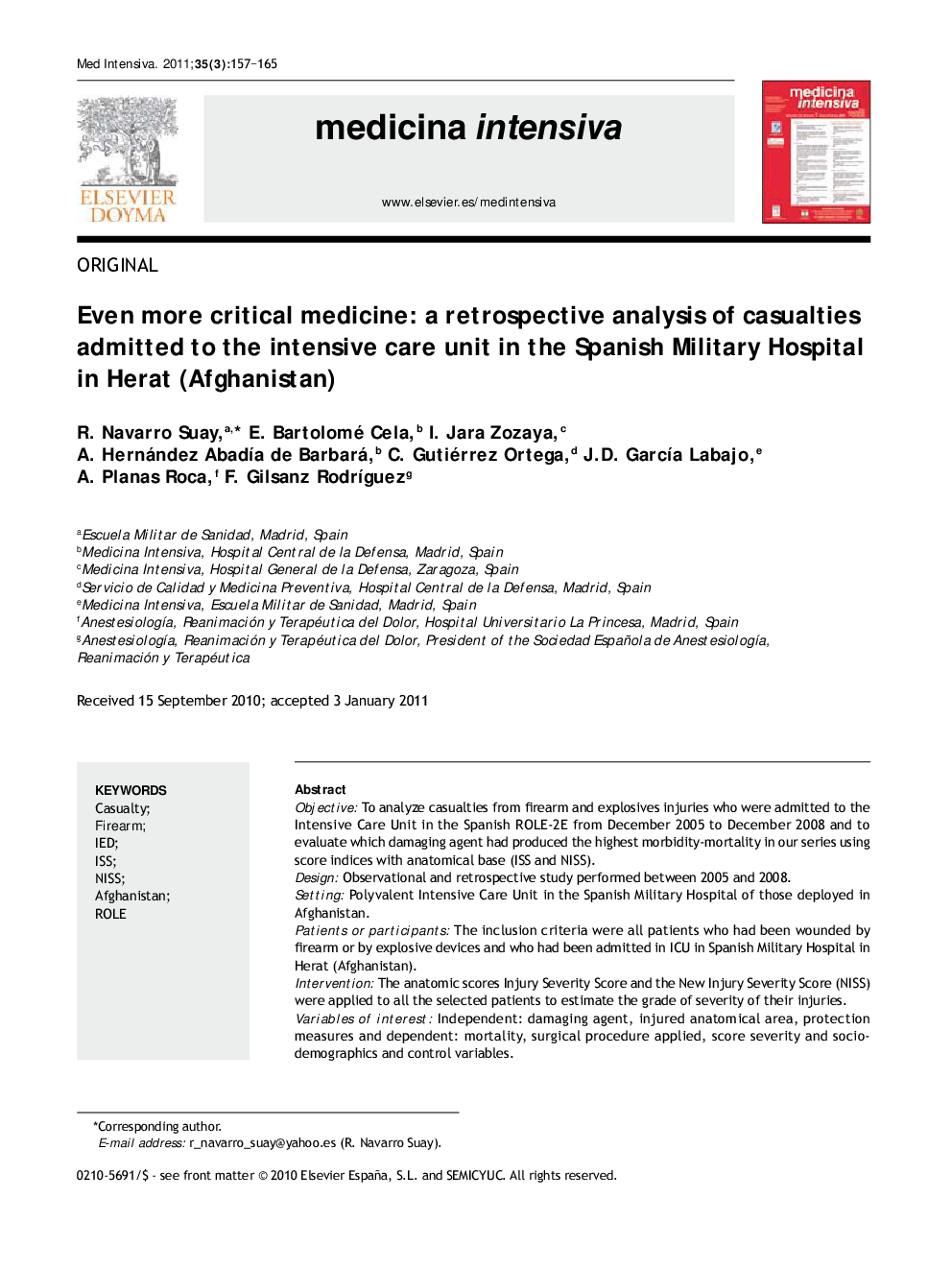| Article ID | Journal | Published Year | Pages | File Type |
|---|---|---|---|---|
| 3114255 | Medicina Intensiva (English Edition) | 2011 | 9 Pages |
ObjectiveTo analyze casualties from firearm and explosives injuries who were admitted to the Intensive Care Unit in the Spanish ROLE-2E from December 2005 to December 2008 and to evaluate which damaging agent had produced the highest morbidity-mortality in our series using score indices with anatomical base (ISS and NISS).DesignObservational and retrospective study performed between 2005 and 2008.SettingPolyvalent Intensive Care Unit in the Spanish Military Hospital of those deployed in Afghanistan.Patients or participantsThe inclusion criteria were all patients who had been wounded by firearm or by explosive devices and who had been admitted in ICU in Spanish Military Hospital in Herat (Afghanistan).InterventionThe anatomic scores Injury Severity Score and the New Injury Severity Score (NISS) were applied to all the selected patients to estimate the grade of severity of their injuries.Variables of interestIndependent: damaging agent, injured anatomical area, protection measures and dependent: mortality, surgical procedure applied, score severity and sociodemographics and control variables.ResultsEighty-six casualties, 30 by firearm and 56 by explosive devices. Applying the NISS, 38% of the casualties had suffered severe injuries. Mean stay in the ICU was 2.8 days and mortality was 10%. Significant differences in admission to the ICU for the damaging agent were not observed (P = .142).ConclusionsNo significant differences were observed in the need for admission and stay in the ICU according to the damaging agent. The importance of the strategy, care and logistics of the intensive care military physician in Intensive Medicine in the Operating Room in Afghanistan is stressed.
ResumenObjetivoAnalizar las bajas por arma de fuego o por explosivo que ingresaron en la UCI del ROLE-2E español entre diciembre de 2005 y diciembre de 2008 y valorar mediante puntuaciones anatómicas de gravedad (ISS y NISS) cuál es el agente lesional que ha producido mayor morbimortalidad en nuestra serie.DiseñoEstudio observacional retrospectivo efectuado entre los años 2005 y 2008.ÁmbitoUnidad de Cuidados Intensivos polivalente del Hospital Militar español desplegado en Afganistán.Pacientes o participantesEl criterio de inclusión fue el de todos los pacientes que sufrieron heridas por arma de fuego o lesiones por artefacto explosivo y que fueron ingresados en la UCI del Hospital Militar español de Herat (Afganistán).IntervencionesA los pacientes seleccionados se les aplicó las puntuaciones anatómicas Injury Severity Score (ISS) y New Injury Severity Score (NISS) para estimar el grado de gravedad de sus lesiones.Variables de interésIndependientes: agente lesional, área anatómica afectada, empleo de medios de protección, y dependientes: mortalidad, necesidad de intervención quirúrgica, gravedad según scores, y sociodemográficas y de control.ResultadosOchenta y seis bajas; 30 por arma de fuego y 56 por artefacto explosivo. El 38% estaba valorado como grave por NISS. La estancia media fue de 2,8 días y la mortalidad del 10%. No se observan diferencias significativas de ingresos en UCI según el agente lesional (p = 0,142).ConclusionesNo se observan diferencias significativas en necesidad de ingreso y de la estancia en UCI según el agente causante de las lesiones. Se destaca la importancia táctica, asistencial y logística del médico militar especialista en medicina intensiva en el teatro de operaciones de Afganistán.
